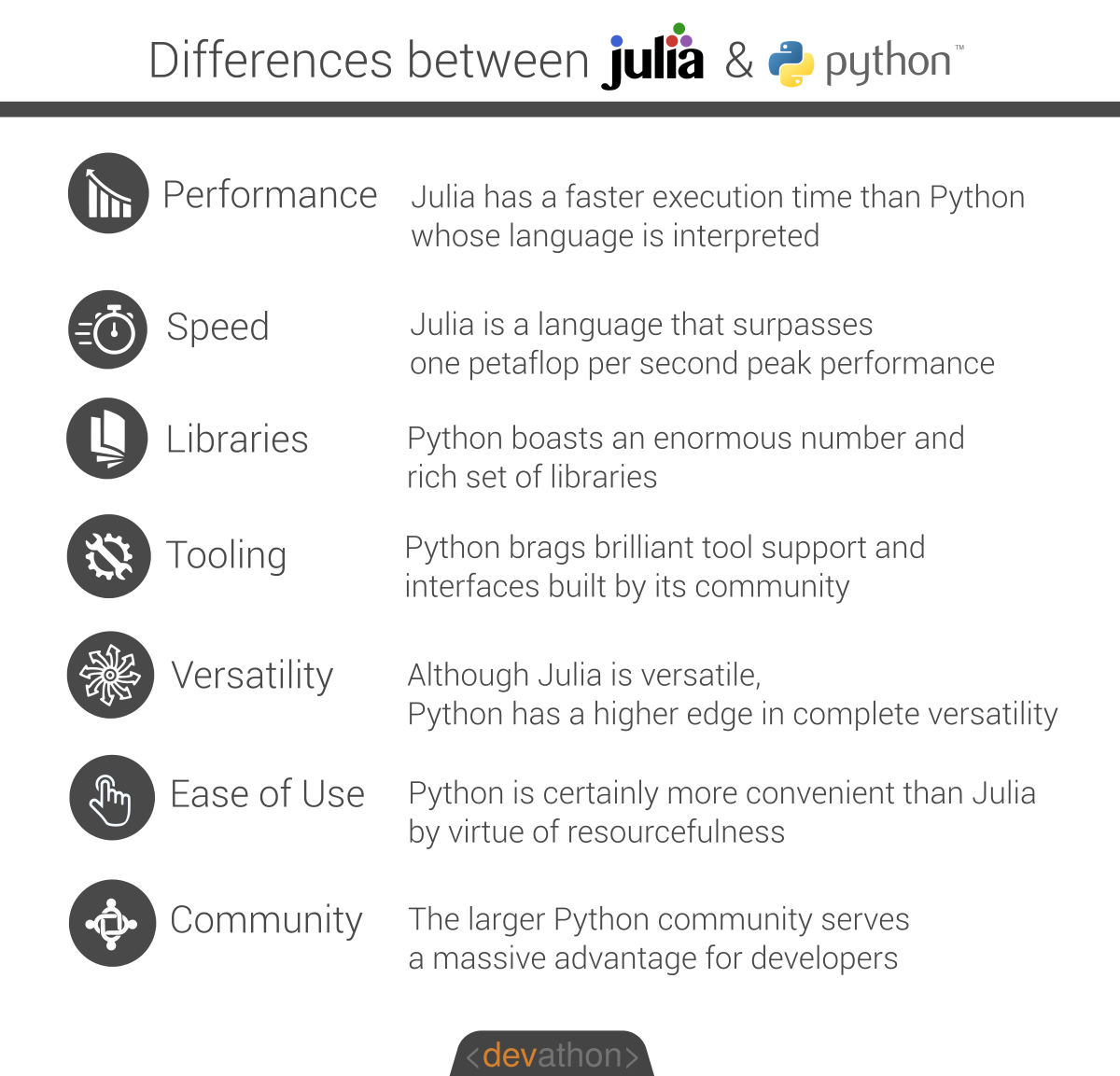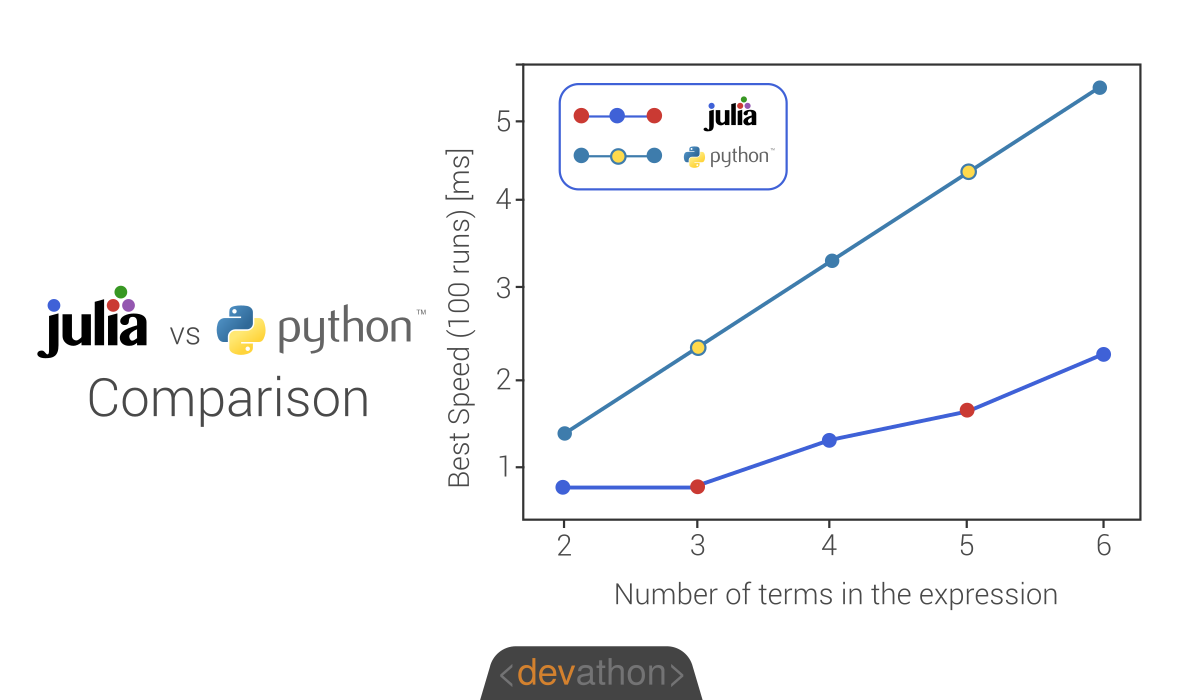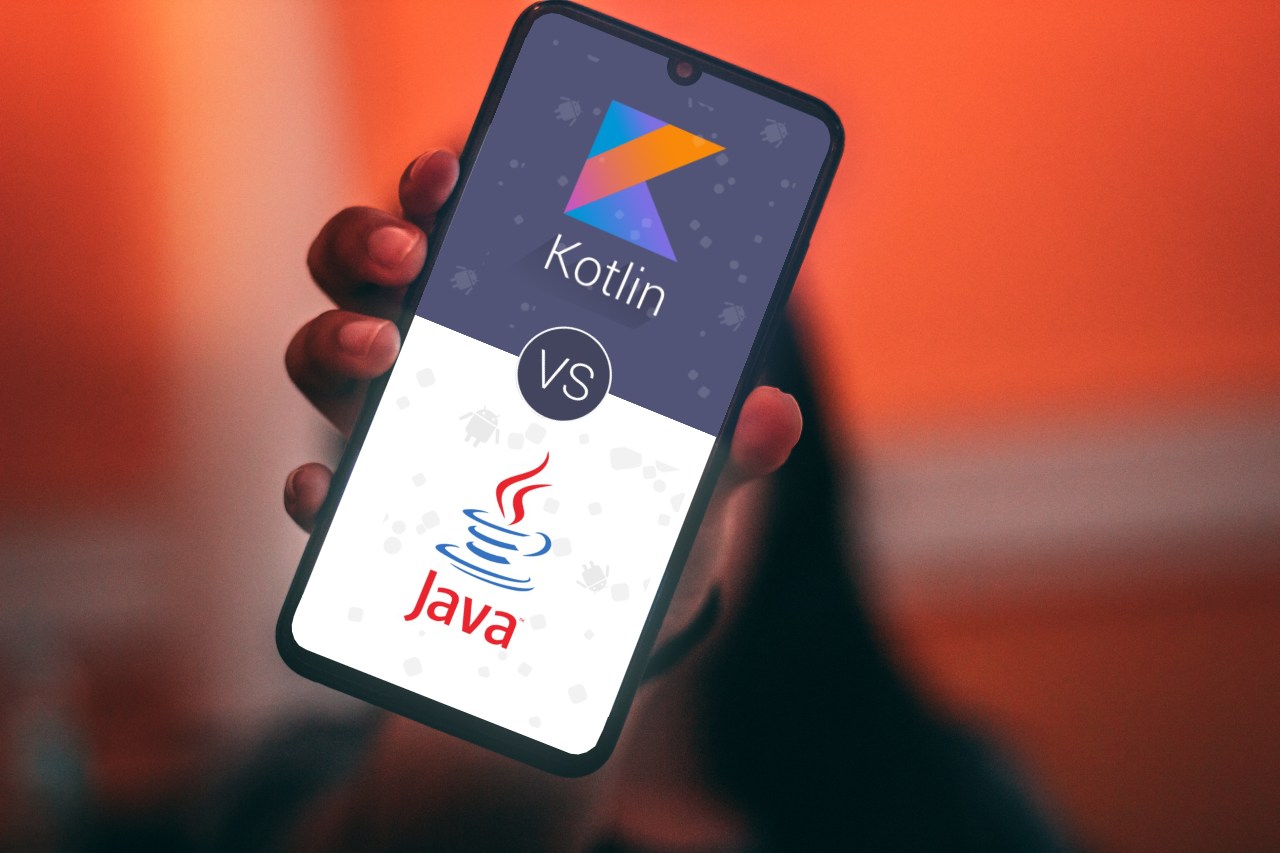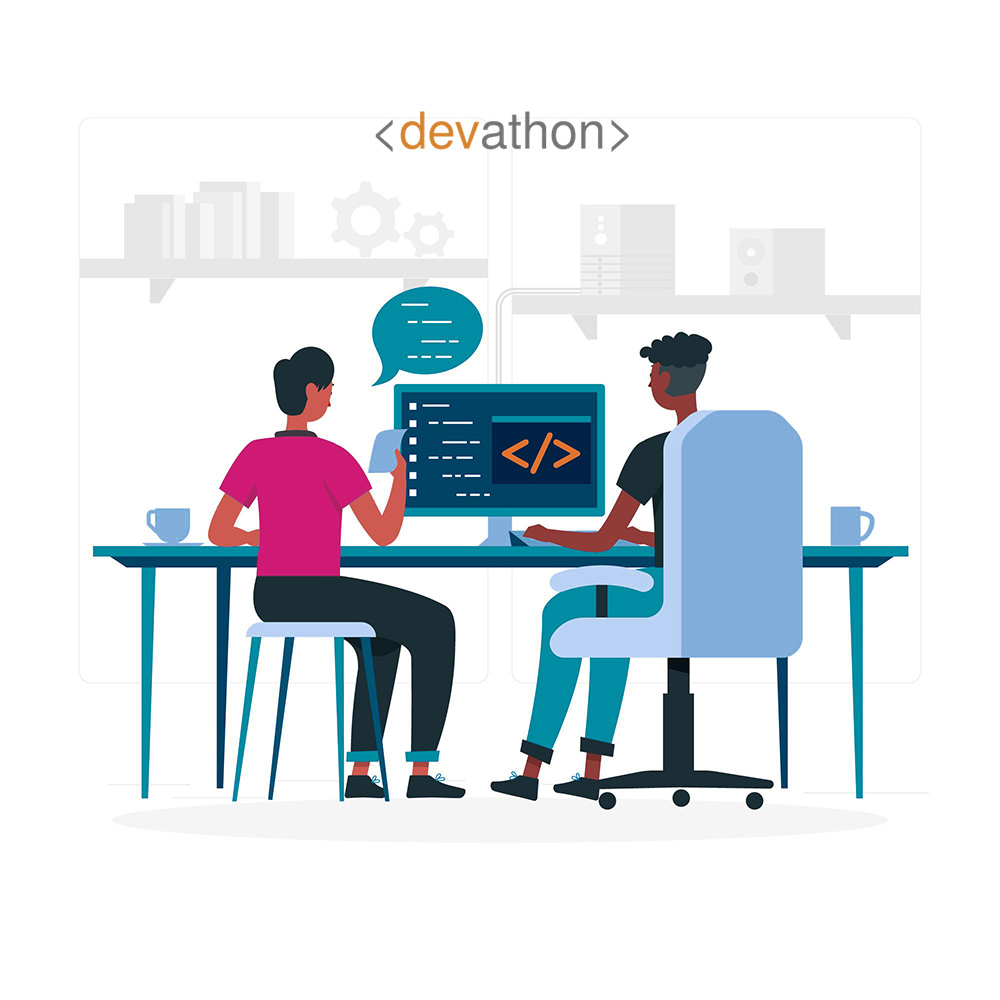Julia Vs Python: Which Programming Language is Better?

As many of us know and can agree, Python is one of the most preferred programming languages backed by a strong community of developers. So far, Python’s popularity is now vast and beyond what it was years ago. As per the TIOBE index, Python claimed the honor of being the programming language of the year 2018 and continues to attract more users. Additionally, it’s worth noting that a SlashData State of the Developer Nation 18th edition April 2020 report indicates that Python has reached 8.4M active developers, surpassing Java’s 8.2M active developers, C# 5.8M, and C/C++ 6.3M in terms of popularity.
Despite such remarkable numbers, the situation begs the question – why is Python a well-established language, now comparable to Julia, a reasonably new language?
Well, since its inception, Julia has quickly attracted the admiration of many developers to become a programming language to keep an eye on. In fact, a TIOBE Index report for May 2020 ranks Julia at position 39 with a 0.27% rating. This indicates that Julia is quickly flourishing in the programming world, given its newness. And with the spotlight on Julia, it is now touted as a potential challenger to Python springing the ‘Julia vs Python’ rivalry conversation.
In this article, we delve deeper into the Julia vs Python debate to provide an insightful and detailed analysis of both programming languages. Read on to have a clear and in-depth understanding of the two languages. Thereafter, you can deliver your verdict on the Python vs Julia show-down and choose the language that suits you best.
Python: A Brief Intro

Python is an interpreted, object-oriented, high-level and multi-paradigm programming language with dynamic semantics. The language was created in 1991 by Guido van Rossum as a successor to his previous language ABC. He took all the useful features and syntax of ABC to create a new language; Python.
Further, Python is a general-purpose language that features high-level in-built data structures as well as dynamic typing, dynamic binding, and many more features. This makes Python convenient for use in Complex or Rapid Application Development or as a scripting or glue language that connects components.
Key Features of Python
- Easy to code and learn
- Free and Open Source with a Python Software Foundation License
- Object-Oriented Language
- Dynamically Typed Language
- GUI Programming Support
- High-Level Language
- Extensible Language
- Portable Language
- Multi-platform Language
- Interpreted Language
- Large Standard Library
Who Uses Python?
Over its existence, Python has emerged as a crucial programming language for various companies and startups. Owing to its versatility and simplicity, Python is used and continues to play a vital role in giant companies such Wikipedia, Google, Yahoo!, Dropbox, CERN, NASA, Reddit, Facebook, Amazon, Instagram, Netflix, Spotify, ILM etc.
Elsewhere, Python has been successfully embedded in many software products as a scripting language such as 3ds Max, Abaqus etc. Also, Python is used in video games, information security, AI and machine learning projects. Not to mention, it’s frequent use as an intro language into computer sciences courses across the globe. While the list is endless, it gives the idea to Python’s popularity as the language of choice for many companies and institutions.
An Introduction to Julia Programming Language
 Founded in 2009 and launched in 2012, Julia is an open-source, high-performance, high-level, and dynamically-typed programming language. As its four creators blatantly say it, Julia was created in the name of greed; to resolve the inadequacies of other programming languages while also integrating the unique and desirable features of the same languages.
Founded in 2009 and launched in 2012, Julia is an open-source, high-performance, high-level, and dynamically-typed programming language. As its four creators blatantly say it, Julia was created in the name of greed; to resolve the inadequacies of other programming languages while also integrating the unique and desirable features of the same languages.
While initially designed as a general-purpose programming language, Julia greatly thrives at numerical and scientific computing. The language uses multiple dispatches as its central programming paradigm and supports parallelism in three primary levels, namely: Julia co-routines (green threading), multi-threading, and multi-core or distributed processing.
Julia’s ease of use, speed, and appropriateness for big-data applications through its high-level support for cloud computing and parallelism have helped facilitate its growth quickly. The language, therefore, continues to appeal to new users.
Key Features of Julia Programming Language
- Free, open-source and MIT licensed program
- Easy to learn with math friendly syntax
- Compiled, not interpreted which makes it fast
- High-performance language similar to statically-typed languages
- Dynamically typed language
- Designed for parallel and distributed computing
- Quick and compact user-defined types as built-ins
- Interoperability with other programming languages like C, Python, etc.
- Lisp-like macros and other metaprogramming facilities
- Integrated package manager
- Allows co-routines and lightweight green threading for automatic memory management
- Allows the automatic generation of useful specialized codes used for different argument types
- Multiple dispatch model, making it easy to express functional behaviors across many combinations of arguments or programming patterns
- Extremely extensible
- Supports encoding via Unicode, UTF-8, etc.
Who Uses Julia?
With Julia being exceptionally fast and high performing, it comes as no surprise that it has drawn the attention of prominent users. Specifically, Julia language is very popular among mathematicians and data scientists.
BlackRock uses Julia for time-series analysis while British insurer Aviva uses it to calculate risks. Beyond that, the Federal Reserve Bank of New York has previously used Julia in modeling the USA’s economy, noticing that Julia’s model estimation was nearly ten times faster than its previous language MATLAB.
Most notably, the Celeste project, which is a Julia-based project used the language to catalogue telescopic data for all visible astronomical objects. The project became the first Julia-based application to record a 1.54 PF/s (petaflops) peak performance in just 14.6 minutes, setting a new scientific milestone. Other key users of Julia include NVIDIA, CISCO, the Climate Modeling Alliance, Cancer Research UK, QuantEcon, etc. with the list growing. Other uses include but are not limited to fields such as data science, AI, machine learning, and visualization.
Julia Vs Python: A Detailed Comparison
 In this section, we look at Julia vs Python in terms of pros and cons. Read on to understand how Julia and Python languages compare when they go head to head.
In this section, we look at Julia vs Python in terms of pros and cons. Read on to understand how Julia and Python languages compare when they go head to head.
Julia vs. Python: Performance
Performance-wise, Julia vs Python takes a twist. Julia is a compiled language which means that programs written in Julia are directly executed as executable code.
Therefore, . Julia code is also universally executable with languages like Python, C, R, etc. It provides impressive, efficient, and rapid results with no need for many optimizations and native profiling techniques. Some optimization in Julia can also not be used in Python. Basically, projects from other languages can be written once and naively compiled in Julia making it ideal for machine learning and data science. The time taken by Julia to execute big and complex codes is lesser to Python’s.
Python not only takes some time to implement codes but requires several optimization methods and external libraries that highlight Julia’s performance excellence.
Python vs. Julia: Speed
Speed was one of the main objectives in the creation and development of Julia. The need for a programming language with the speed of C, and for a fact, Julia doesn’t disappoint!
Interestingly, Julia is a member of the Petaflop Club which comprises computing languages that surpass a one petaflop per second peak performance. So, what makes Julia fast?
 As mentioned above, Julia is not interpreted hence uses just-in-time (JIT) compilation and type declarations to execute codes that involve compilation at run time. Julia impresses at complex numerical and computational functions since it is designed to quickly execute codes. Further, its multiple dispatch quickly defines data types like numbers and arrays. In comparison, Python is fast but not as Julia. However, with ongoing speed Python interpreter improvements, Python can be made faster via external libraries, optimization tools and third-party JIT compilers. Still, Julia’s speed is superior to Python’s as illustrated by the graph below.
As mentioned above, Julia is not interpreted hence uses just-in-time (JIT) compilation and type declarations to execute codes that involve compilation at run time. Julia impresses at complex numerical and computational functions since it is designed to quickly execute codes. Further, its multiple dispatch quickly defines data types like numbers and arrays. In comparison, Python is fast but not as Julia. However, with ongoing speed Python interpreter improvements, Python can be made faster via external libraries, optimization tools and third-party JIT compilers. Still, Julia’s speed is superior to Python’s as illustrated by the graph below.
Julia vs Python: Libraries
In terms of libraries and packages, Python takes the cake in Python vs Julia face off. Given its infancy, Julia has a limited number of libraries. Besides, the libraries aren’t very well maintained, taking considerably longer to plot and execute data. Regardless, Julia’s library is steadily growing, and it can directly interface with foreign libraries of Fortran, C++, Python, R, Javascript, etc. to handle plots.
In contrast, Python boasts an enormous number and rich set of libraries, mainly due to its lengthy existence and popularity. More so, these libraries are well maintained, making it easy to perform various additional tasks. Python is also supported by a significant number of third-party libraries, which makes it a favorite among developers and programmers.
Python Vs Julia: Tooling Support
Tooling support is an essential aspect of any programming language. Python easily takes the lead over edges Julia. Having a supportive and active programming community, Python brags brilliant tool support, systems, and interfaces built by its community.
However, Julia lacks substantial support and many great resources, debugging tools, or resolving issues with a performance like Python does.
Python Vs Julia: Versatility
Although Julia is versatile, Python has a higher edge in terms of complete versatility. Python is still the choice for most programmers, as it is a comprehensive language. There’s a bag full of functions you can do with Python that you cannot do with Julia. Python efficiently performs different purposes such as web scripting, development, automation, algorithmic functions, and many more. What’s more, these functions are simultaneously executable.
Julia, on the other hand, can also perform various functions but is crafted for the scientific programming community. It quickly and efficiently does complex data processing and implementation of mathematical and algorithmic tasks for machine learning better than Python.
Python Vs. Julia Ease of Use
While both Julia and Python languages are easy to use, it all comes down to the area of use. For starters, Julia’s mathematical syntax mirrors how we write mathematical formulae, making it the perfect language for scientific algorithms or mathematical-based programming. Better yet, Julia is still convenient for writing other codes at a significant speed and specific features but may inconvenience users due to limited resources.
Moving on, Python is certainly more convenient than Julia by virtue of resourcefulness and a wide range of libraries as well as support. Moreover, its code-friendly syntax is straightforward and can be used to perform various functions at a go. Even new users can quickly learn and comprehend the Python language.
Python Vs. Julia: Development Community
For any programming language to be successful and position itself as a force, a massive, dedicated, and active community is indispensable. With Python hitting the three-decade mark recently, it has amassed a vast and supportive community over that period.
Consequently, the development and growth of Python has taken leaps forward, often branded as the fastest-growing programming language. The large Python community serves a massive advantage for developers since it allows multiple resources to resolve any problems and doubts. There’s barely any Python-related issue you cannot get assistance.
Unlike Python, Julia is a new language yet to hit the decade mark. As such, it has a small community meaning that developers might need to dig deeper to resolve doubts and other problems. However, an advantage to it is that you may run into the same people, which may lead to valuable relationships. Overall, Julia’s community is in its development stage and is showing all the right signs of being a future star.
The table below summarizes the main differences between Julia and Python
| Feature | Python | Julia |
| Popularity | Python has been in existence for three decades now gaining a huge following and backing that make it an extremely popular language. | Being a new language, Julia’s popularity though accelerating is to a great extent far from Python’s status. |
| Maturity | Python is more mature owing to its lengthy existence, development, libraries, and community support. | Julia is reasonably new and requires more development, increased, and well-maintained libraries and a large community to achieve a high maturity status. |
| Performance | Python is an interpreted language and its code must be interpreted prior to execution. However, optimization performance improves significantly. | Julia is a compiled language hence code execution occurs as it is written. This equates to fast execution time and high performance. |
| Code Conversion | Python codes are demanding to make by converting C codes or vice versa. | Julia codes can be easily made by converting C, Python, or other language codes. |
| Speed | Python is fast but not up to C and Julia’s speed. Still, Python has become easier to speed up of late. | Julia is faster than Python courtesy of a high execution speed that can match or exceed that of C. |
| Versatility | Python is a general-purpose language that can be used to perform different functions. | Although Julia is also general-purpose, it is best suited for scientific computing functions. |
| Libraries | Python has extensive libraries as well as support from third-party libraries, making it easy to perform multiple tasks. | Julia has limited library support but can interface with other language libraries to handle plots. |
| Community
|
Python has a large community having been around for long. It is, therefore, easy to get help and solve problems online. | Julia’s infancy means it has a small community, hence limited online resources for problems solving. |
| Array Indexing | Like most languages, Python arrays feature 0-based indexing. | Julia’s arrays feature 1- based indexing which might be problematic for programmers used to 0-indexing. |
| Dynamically typed
|
Python is only dynamically typed which helps in the creation of variables in the absence of type declaration. | Julia is not only dynamically typed but also statically typed. This helps in the creation of variables without specifying their types. |
| Parallelism
|
Python can run parallel operations. However, it requires serialization and deserialization of data when parallelizing between threads. | Julia’s has superior parallelization with stabilized parallelization syntax, which reduces its usage threshold. |
| Identifying issues | Python excels in identifying and solving tools largely to its huge support. | Julia does not shine at identifying issues yet. |
Features
Popularity:
Python is an interpreted language and its code must be interpreted prior to execution. However, optimization performance improves significantly.
Julia is a compiled language hence code execution occurs as it is written. This equates to fast execution time and high performance.
Maturity
Python is more mature owing to its lengthy existence, development, libraries, and community support.
Julia is reasonably new and requires more development, increased, and well-maintained libraries and a large community to achieve a high maturity status.
Performance
Python is an interpreted language and its code must be interpreted prior to execution. However, optimization performance improves significantly.
Julia is a compiled language hence code execution occurs as it is written. This equates to fast execution time and high performance.
Code Conversion
Python codes are demanding to make by converting C codes or vice versa.
Julia codes can be easily made by converting C, Python, or other language codes.
Speed
Python is fast but not up to C and Julia’s speed. Still, Python has become easier to speed up of late.
Julia is faster than Python courtesy of a high execution speed that can match or exceed that of C.
Versatility
Python is a general-purpose language that can be used to perform different functions.
Although Julia is also general-purpose, it is best suited for scientific computing functions.
Libraries
Python has extensive libraries as well as support from third-party libraries, making it easy to perform multiple tasks.
Julia has limited library support but can interface with other language libraries to handle plots.
Community
Python has a large community having been around for long. It is, therefore, easy to get help and solve problems online.
Julia’s infancy means it has a small community, hence limited online resources for problems solving.
Array Indexing
Like most languages, Python arrays feature 0-based indexing.
Julia’s arrays feature 1- based indexing which might be problematic for programmers used to 0-indexing.
Dynamically typed
Python is only dynamically typed which helps in the creation of variables in the absence of type declaration.
Julia is not only dynamically typed but also statically typed. This helps in the creation of variables without specifying their types.
Parallelism
Python can run parallel operations. However, it requires serialization and deserialization of data when parallelizing between threads.
Julia does not shine at identifying issues yet.
Identifying issues
Python excels in identifying and solving tools largely to its huge support.
Julia does not shine at identifying issues yet.
Conclusion
By now, we’re sure you can easily pass judgment on who takes the crown in Julia vs Python’s face-off. Although Julia is attracting some attention and making a name for itself, Python is not falling back in the same race. Whichever language you might opt for, many factors have to be considered since each language has its strengths and drawbacks. Fast-forward to the future, both Julia and Python have a brighter future in the big data, data science, AI, and machine learning fields, and there’s no assurance of what may happen. Nevertheless, Julia has a long journey ahead should it want to match Python’s footprint in the aforementioned fields. Only with full maturity which might be years away and a mass community following can Julia increase its relevance as a programming language and achieve complete industry adoption.
Then again, with the knowledge of Julia’s abilities, Python will only improve on its weaknesses. Python will also continue to be a big player in all technology fields and a skill that is sought after regardless of Julia’s upsurge. Both languages will, however, have to share from the same plate. Overall, with both languages showing promise, the competition can only get better. For developers, Python vs Julia highly stresses the need for having more than one arrow in your programming language quiver.
Are you looking to get your App built? Contact us at hello@devathon.com or visit our website Devathon to find out how we can breathe life into your vision with beautiful designs, quality development, and continuous testing.






